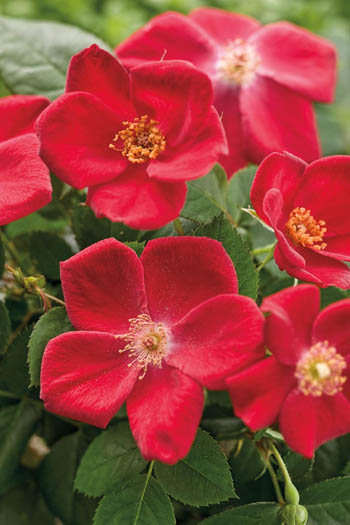Roses are the queens of the summer garden. But growing them can be tricky in this humid climate, especially this year, when we endured a cold spring, then a wet June, and searing, humid heat in July.
If you love the idea of roses in your landscape but don’t have much time to devote to them, consider planting a newer class of roses, called landscape roses, bred to perform well all summer long. The best-known, Knock Out roses, have been showing up in increasing numbers in local nurseries and garden centers. A second generation, Home Run roses, has hit the market in the last year or two.
 |
|
Red Home Run roses have bright yellow centers. (Photo: ProvenWinners.com) |
Adding Roses to Your Landscape
You can plant landscape roses in a mixed bed or border along with perennials, annuals or other shrubs. Or, plant them in their own bed, or in a row for a low hedge. They’ll also thrive in a large container.
The plants grow 3 to 4 feet high and equally wide. They bloom all summer until the first hard frost in fall, and need no deadheading. They tolerate drought and resist black spot disease. Home Run roses also resist powdery mildew. The flowers bloom on short stems so they’re not good for cut flowers. But they’re perfect for a low-maintenance garden.
Members of the Clan
The color range for landscape roses is still limited, but it’s expanding. Most of the flowers have a single row of petals, unlike the many-petalled flowers of many favorite hybrid teas, grandifloras, floribundas and shrub roses. The original Knock Out rose has cherry red flowers; there’s also a fuller double variety. There are both single and double-petalled varieties in pink. The varieties Rainbow (pink with a yellow central “eye”), Blushing (light pink), and Sunny (yellow) all have a single layer of petals. Home Run roses come in just red and pink, so far. All the varieties are patented and must be purchased as plants, not seeds.
How to Grow Them
These roses need full, unobstructed sun for at least six hours a day to perform their best, so choose their location carefully. To plant, dig a hole as keep as the plant’s nursery pot and twice as wide. Loosen the soil in the bottom of the hole with your shovel. Remove the plant from its pot and gently loosen the roots in the bottom of the root mass. Set the plant in the hole so that the base of the stem is level with the surrounding soil. Fill in around the plant with soil, firm it around the plant, and water well.
During the growing season, water the roses during spells of dry weather. Fertilize the plants in spring with an all-purpose organic fertilizer.
You don’t have to prune these roses. If you want to keep the plants lower than four feet, prune them in early spring, after the last hard frost, cutting back the stems to 1 to 1 ½ feet high.












